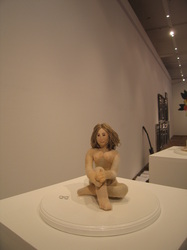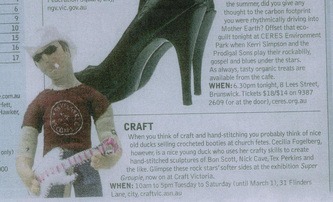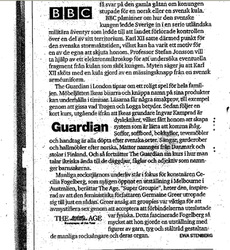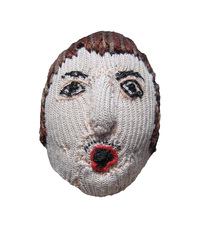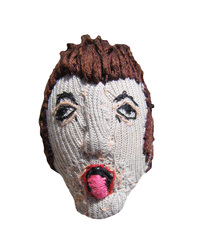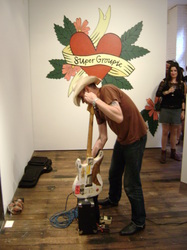SUPER GROUPIE
Solo show : SUPER GROUPIE, Craft Victoria, 31 Flinders Lane, Melbourne, 30 January-1 March 2008
Solo show featuring hand stiched sculptures of: Tex Perkins, Ian Rilen, Steve Lucas, Nick Cave, Bon Scott, Ben & Geoffro Corbett, Mick Harvey, Conway Savage, Kim Volkman, Spencer P. Jones, Tristan Miller, Rowland S Howard, Brian Hooper, Angry Anderson, Germaine Greer, 'The Boy' and Steve Erwin.
All sculptures are approximately 30x30x30 cm made from recycled fabric, coffee stained cotton fabric, wire, cotton thread, cotton wool, painted mdf, some of the sculptures featuring parts of found objects.
The exhibition also features Trevor Flinn’s sculpture installation ‘MARSHALLSTACK’.
All sculptures are approximately 30x30x30 cm made from recycled fabric, coffee stained cotton fabric, wire, cotton thread, cotton wool, painted mdf, some of the sculptures featuring parts of found objects.
The exhibition also features Trevor Flinn’s sculpture installation ‘MARSHALLSTACK’.
Media release - Craft Victoria
The first Show at Craft Victoria with its own My Space and Guitar Solo opening 'speech' will also be our first exhibition for 2008. Cecilia Fogelberg brings Rock 'n' Roll to Craft Victoria with knitted sculptures of her favourit Australian Rock Gods including Bon Scott, Nick Cave, Ian Rilen, Tex Perkins and Angry Anderson. The sculptures have been inspired by arch-feminist Germaine Greer, the priginal 'super groupie'. Fogelberg's sculptures poist men as sex objects and in the spirit of Greer's feminist politics encourage an active female aestheticism. Taking the form of 'collector dolls', the sculptures are either full-sized figures or singula parts of the male anatomy. Fogelberg studied at the Victorian College of the Arts and has exhibited in Craft Victoria's annual showcase of the best graduate work from around the state - Fresh! The exhibition will be opened by legendary musician Spencer P. Jones (Beast of Bourbon) and will be followed by an After Party at Melbourne's Cherry Bar in AC/DC Lane, featuring X and The Rackets.
Media coverage - The Age
Media coverage - Dagens Nyheter - Sweden
Media coverage - City Search
Super Groupie - Cecilia FogelbergA fresh young artist demonstrates her devotion to the gods of Australian rock with her series of soft sculptures.
Swedish-born sculptor Cecilia Fogelberg is putting the love back into rock'n'roll. With her Super Groupie exhibition, the Melbourne-based artist presents a series of hand-stitched soft sculptures of her favourite Australian rockers. Here the men of her devotion appear as either full-sized figures or singular parts of the male anatomy. Musicians like Tex Perkins, Angry Anderson and Bon Scott are revealed as plush toys, but far from being cute teddy bear versions of the rockers, these anatomically exaggerated figures are more rock beasts than men.
Though the subject matter, and even the exhibition title, may suggest a certain chauvinism, the work is actually inspired by feminist Germaine Greer - the original 'super groupie'. Fogelberg celebrates female sexuality by her objectivity of the men she has featured here, transforming their giant onstage personas into dolls. Fogelberg lists her current artistic interest as 'Australia, the rock, the cock, female active sexuality, the rock star', all elements she has brought together in Super Groupie.
The exhibition will open with a speech and guitar solo from Spencer P Jones, of the Beats of Bourbon, and will be followed by an after party at Melbourne's Cherry Bar - with music by X and The Rackets.
Kashmir Brummel
Swedish-born sculptor Cecilia Fogelberg is putting the love back into rock'n'roll. With her Super Groupie exhibition, the Melbourne-based artist presents a series of hand-stitched soft sculptures of her favourite Australian rockers. Here the men of her devotion appear as either full-sized figures or singular parts of the male anatomy. Musicians like Tex Perkins, Angry Anderson and Bon Scott are revealed as plush toys, but far from being cute teddy bear versions of the rockers, these anatomically exaggerated figures are more rock beasts than men.
Though the subject matter, and even the exhibition title, may suggest a certain chauvinism, the work is actually inspired by feminist Germaine Greer - the original 'super groupie'. Fogelberg celebrates female sexuality by her objectivity of the men she has featured here, transforming their giant onstage personas into dolls. Fogelberg lists her current artistic interest as 'Australia, the rock, the cock, female active sexuality, the rock star', all elements she has brought together in Super Groupie.
The exhibition will open with a speech and guitar solo from Spencer P Jones, of the Beats of Bourbon, and will be followed by an after party at Melbourne's Cherry Bar - with music by X and The Rackets.
Kashmir Brummel
Exhibition Essay by Simon Greg
‘Oi! Oi! Oi!’ chants the teeming crowd, heads nodding in time, tattoo-covered fists punching the air, sweat flying upwards into a space impregnated with alcohol and body odour – not the usual day at the art gallery then. In Super Groupie, Cecilia Fogelberg transplants the soul of the Australian rock icon into a mesmeric series of soft sculptures – her ‘top 10’ – that capitulate the hedonism and moral corruption of the country’s bars, hotels and sticky-floored band venues into the high-art arena.
Earlier Cecilia Fogelberg exhibitions were like entering a dream; or a nightmare, depending on how long you spent in it. Mythological beasts, Gods, and demons abounded, glorified as hand-stitched and sewn soft toys. Emerging from fairy tales and nursery rhymes, the creatures came to us as depraved sex monsters, relishing in their ‘sinful’ embellishments of bodily mutations and genital exaggerations.
I'm the devil's advocate. We have our own worshippers who are called 'groupies.' Girls will give their bodies to musicians as you would give a sacrifice to a god.
Frank Zappa, quoted in Peters Brothers, What About Christian Rock, p. 17
In Super Groupie Fogelberg turns her formidable stitching needle toward the most depraved, most beastly and most mythological creature of all – the Oz Rocker. Since her arrival from Sweden in 1999 Fogelberg has become immersed in the local rock scene, and describes her current artistic concerns as ‘Australia, the rock, the cock, female active sexuality, the rock star’.
Super Groupies don't have to hang around hotel corridors. When you are one, as I have been, you get invited backstage. I think groupies are important because they demystify sex; they accept it as physical, and they aren't possessive about their conquests.
Germaine Greer, New York Times, 1971
In her title Super Groupie Fogelberg references Germaine Greer’s comments in New York, 1971. Fogelberg embraces Greer’s philosophical refrain by celebrating sexual hedonism and the ‘male gaze’, but turns this gaze back onto the Gods of rock. With the muso as muse, and still infected with the dreamy otherworldliness of mythology and the collective unconscious, her creatures are the canvas upon which the artist’s preoccupations are played out.
To the sound of grisly riffs and throbbing bass, Jungian symbolism is set on the rampage with the Animus (masculine image in the woman’s psyche) and the Anima (feminine image in a man’s psyche) smashing whisky bottles over each others’ heads.
Rock has always been the devil’s music . . . I believe rock and roll is dangerous . . . I feel we're only heralding something even darker than ourselves.
David Bowie, Rolling Stone, 12 Feb 1976
Fogelberg has canonised the archetypes of antipodean rock with the unique perspective of the outsider. She describes this unique Top 10 of Oz Rockers as a ‘personal journey’ – but this is no Glen A. Baker history of Rock ‘n’ Roll, but rather, an eclectic romp past the musical signposts of Fogelberg’s time in Australia. The resulting figurines – of some of the most uncouth rockers to emerge from this country – are rendered pathologically whimsical and helplessly adorable by virtue of their deification into plush toys.
They don't even know what it is to be a fan. You know, to truly love some silly little piece of music or some band so much that it hurts.
Rock groupie ‘Sapphire’, Almost Famous, 2000
Adorable they may be, but the rock icon’s enduring resonance stems from their simultaneous repulsion. This is how Fogelberg registers her devotion as a fan. Witness Tex Perkins: arms folded with his trademark smarmy look wrapped around his brick-like head; but Fogelberg reveals what the Rolling Stone photographer missed – Perkins’ penis distends from his groin like a third leg, curling hypnotically around the floor and ending in a hissing dragon head. Likewise her other subjects are willingly disfigured - Bon Scott, Nick Cave, Spencer P Jones, Angry Andersen, Ian Rilen, Mick Harvey, Conway Savage, Rowland S Howard, and Kim Volkman are all presented like collectors’ dolls fresh out of their packaging. But here they are the antithesis of the anatomically correct wax sculpture; in Fogelberg’s hands the awkward, lumpen figurines are invariably misshapen, revelling in the thrill of a tempered ineptitude.
Like teddy bears after a testosterone binge, these iconoclastic voodoo dolls conspire to subvert the medium – how could a needle and thread be capable of such vulgarity? But in cleverly manipulating the material, Fogelberg renders what might otherwise be vulgar as disarming, alluring and beautiful. Fogelberg admits to exploiting this two-sided aspect within her practice: her celebration of female sexuality through the male sex object, her dark humour, and the obvious rupture between cute soft toy and bestial rock pig. Notably free of the blood, sweat and semen they connote, these paeans to paganism nevertheless disturb through their ambiguity of meaning.
After being coerced into such an orgiastic infusion I doubt that any visitor to Cecelia Fogelberg’s latest journey into the collective unconscious will look at a rock icon the same way. Perhaps it’s time we all embraced the super groupie within: ‘Oi!’
Simon Gregg, December 2007
Simon Gregg is curator of City Museum at Old Treasury and erstwhile author of a forthcoming book on the Romantic sublime in contemporary Australian art.
Earlier Cecilia Fogelberg exhibitions were like entering a dream; or a nightmare, depending on how long you spent in it. Mythological beasts, Gods, and demons abounded, glorified as hand-stitched and sewn soft toys. Emerging from fairy tales and nursery rhymes, the creatures came to us as depraved sex monsters, relishing in their ‘sinful’ embellishments of bodily mutations and genital exaggerations.
I'm the devil's advocate. We have our own worshippers who are called 'groupies.' Girls will give their bodies to musicians as you would give a sacrifice to a god.
Frank Zappa, quoted in Peters Brothers, What About Christian Rock, p. 17
In Super Groupie Fogelberg turns her formidable stitching needle toward the most depraved, most beastly and most mythological creature of all – the Oz Rocker. Since her arrival from Sweden in 1999 Fogelberg has become immersed in the local rock scene, and describes her current artistic concerns as ‘Australia, the rock, the cock, female active sexuality, the rock star’.
Super Groupies don't have to hang around hotel corridors. When you are one, as I have been, you get invited backstage. I think groupies are important because they demystify sex; they accept it as physical, and they aren't possessive about their conquests.
Germaine Greer, New York Times, 1971
In her title Super Groupie Fogelberg references Germaine Greer’s comments in New York, 1971. Fogelberg embraces Greer’s philosophical refrain by celebrating sexual hedonism and the ‘male gaze’, but turns this gaze back onto the Gods of rock. With the muso as muse, and still infected with the dreamy otherworldliness of mythology and the collective unconscious, her creatures are the canvas upon which the artist’s preoccupations are played out.
To the sound of grisly riffs and throbbing bass, Jungian symbolism is set on the rampage with the Animus (masculine image in the woman’s psyche) and the Anima (feminine image in a man’s psyche) smashing whisky bottles over each others’ heads.
Rock has always been the devil’s music . . . I believe rock and roll is dangerous . . . I feel we're only heralding something even darker than ourselves.
David Bowie, Rolling Stone, 12 Feb 1976
Fogelberg has canonised the archetypes of antipodean rock with the unique perspective of the outsider. She describes this unique Top 10 of Oz Rockers as a ‘personal journey’ – but this is no Glen A. Baker history of Rock ‘n’ Roll, but rather, an eclectic romp past the musical signposts of Fogelberg’s time in Australia. The resulting figurines – of some of the most uncouth rockers to emerge from this country – are rendered pathologically whimsical and helplessly adorable by virtue of their deification into plush toys.
They don't even know what it is to be a fan. You know, to truly love some silly little piece of music or some band so much that it hurts.
Rock groupie ‘Sapphire’, Almost Famous, 2000
Adorable they may be, but the rock icon’s enduring resonance stems from their simultaneous repulsion. This is how Fogelberg registers her devotion as a fan. Witness Tex Perkins: arms folded with his trademark smarmy look wrapped around his brick-like head; but Fogelberg reveals what the Rolling Stone photographer missed – Perkins’ penis distends from his groin like a third leg, curling hypnotically around the floor and ending in a hissing dragon head. Likewise her other subjects are willingly disfigured - Bon Scott, Nick Cave, Spencer P Jones, Angry Andersen, Ian Rilen, Mick Harvey, Conway Savage, Rowland S Howard, and Kim Volkman are all presented like collectors’ dolls fresh out of their packaging. But here they are the antithesis of the anatomically correct wax sculpture; in Fogelberg’s hands the awkward, lumpen figurines are invariably misshapen, revelling in the thrill of a tempered ineptitude.
Like teddy bears after a testosterone binge, these iconoclastic voodoo dolls conspire to subvert the medium – how could a needle and thread be capable of such vulgarity? But in cleverly manipulating the material, Fogelberg renders what might otherwise be vulgar as disarming, alluring and beautiful. Fogelberg admits to exploiting this two-sided aspect within her practice: her celebration of female sexuality through the male sex object, her dark humour, and the obvious rupture between cute soft toy and bestial rock pig. Notably free of the blood, sweat and semen they connote, these paeans to paganism nevertheless disturb through their ambiguity of meaning.
After being coerced into such an orgiastic infusion I doubt that any visitor to Cecelia Fogelberg’s latest journey into the collective unconscious will look at a rock icon the same way. Perhaps it’s time we all embraced the super groupie within: ‘Oi!’
Simon Gregg, December 2007
Simon Gregg is curator of City Museum at Old Treasury and erstwhile author of a forthcoming book on the Romantic sublime in contemporary Australian art.





